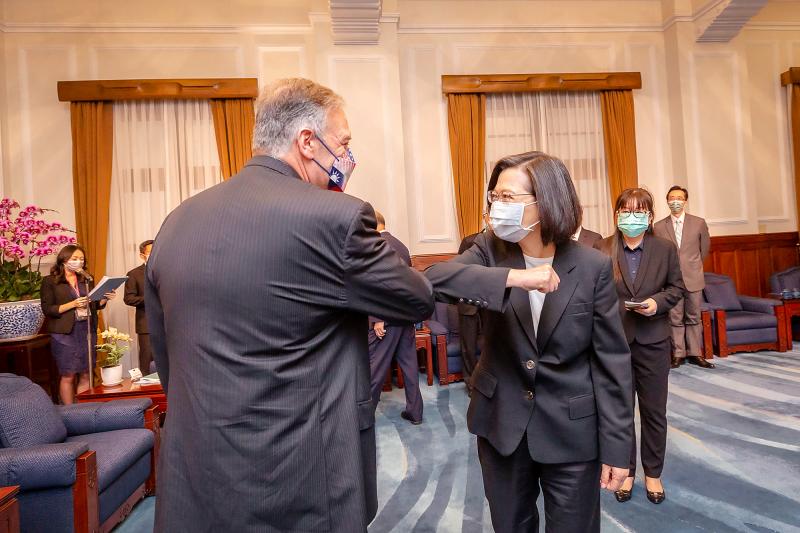Last week Chinese Nationalist Party (KMT) lawmaker and party strategist Fu Kun-chi (傅崐萁), stimulated like all us by the Russian invasion of Ukraine, argued in the legislature that Taiwan should follow “the Finnish model” and not be a “front-line country.”
Ironically, as he was making that argument, Finland, which already cooperates closely with NATO, was debating becoming a NATO member.
Fu’s remark was laughably out of touch with history. Finland became “Finlandized” only after fighting a bitter war against the Russians. Moreover, the Soviet Union agreed to recognize the independent sovereignty of Finland as part of the deal.

Photo: AFP
Imagine Beijing formally recognizing Taiwan’s independent sovereignty! That is why the whole idea of “Finlandizing” Taiwan is entirely mad. Nevertheless, it is a “solution” periodically mooted in the media and in scholarly journals (see, for example, Bruce Gilley’s comical 2010 piece in Foreign Affairs, “Not So Dire Straits: How the Finlandization of Taiwan Benefits US Security”).
NON-ALIGNED
Laugh as we might, let’s not forget that party strategist Fu’s words were actually yet another insidious instance of a long-term strategy of the KMT to sever Taiwan from its protectors, the US and Japan, and re-orient it towards China. This strategy has several simultaneous components.
One aspect of this strategy is signaled by Fu’s “Finlandization” comment: it seeks to make Taiwan “neutral” between China and the US/Japan alliance. This “neutrality” is presented in many different ways. For example, KMT candidates have several times discussed “peace treaties” with China of 30 or 50 years duration, an idea first floated in the mid-1990s by Kenneth Lieberthal, who like many people in Democratic administrations, was part of Stonebridge, a quietly influential consulting firm with a robust China business.
Back in the 2000 election ex-KMTer James Soong (宋楚瑜) floated the idea. Then-president Ma Ying-jeou (馬英九) revived it as the culmination of his “Golden Decade” policies, though he cautiously said it should be submitted to a plebiscite, in the run-up to the 2012 election (ironically, Soong, a candidate from his own party, attacked him). In the 2016 election, foredoomed KMT candidate Hung Hsiu-chu (洪秀柱) also brought up the idea.
“Neutralizing” an island by separating it from its support is also a strategy that China is using in Okinawa, where it quietly supports Okinawan independence for the same reasons it doesn’t support Taiwan independence. Such “neutrality” would make Taiwan an easy target in an invasion.
Hand-in-hand with the peace treaty idea is opposition to weapons purchases and military reforms. Indeed, in many KMT presentations on a “peace treaty” it is explicitly stated that Taiwan would no longer need much in the way of weaponry once a treaty was signed and its security assured (to his credit Ma, ever wise to the need to look pro-Taiwan, downplayed that argument). Remember the vociferous debates over weapons purchases during the administration of Chen Shui-bian (陳水扁)?
As Fu did in his diatribe last week, KMT members constantly say that the US will never come to Taiwan’s aid. Similarly, last week Ma said that the chances were low of US troops coming to Taiwan’s defense. I have heard this resistance-is-futile trope from many KMT supporters.
IRRITATE THE US AND JAPAN
Another aspect of this strategy is irritating relations with Japan (relations between the two are too strong at the moment to entirely destroy) and the US. The Senkaku Islands “dispute” is often used for this purpose. In power, KMT leaders emphasize “Taiwan’s sovereignty” over the islands, hoping also to get people to conflate Taiwan and the Republic of China (ROC).
Out of power, they demand that Democratic Progressive Party (DPP) administrations protect Taiwan’s “sovereignty” over the islands. The Fukushima food ban was part of this approach, as was the KMT’s support of the ban on US food products containing ractopamine, aimed at irritating the US. Ma’s cynical use of the comfort women issue against Japan falls under this category as well.
Fu’s argument for the Finlandization of Taiwan came in an exchange in the legislature with DPP Premier Su Tseng-chang (蘇貞昌), in which he instanced Su’s long-ago ancestry in China. Su retorted that Fu’s speech had the same tone as that of China’s Taiwan Affairs Office (TAO).
This is not by accident. Fu’s call to neutralize Taiwan via Finlandization might have been laughably out of touch, yet it was one among the many Taiwan-Ukraine parallels, the mirror of Russian dictator Putin’s long struggle to keep Ukraine out of NATO so he could invade it. Fu’s positioning of Taiwan would have a similar effect.
Indeed, it is hard to shut one’s eyes to the numerous parallels between the ethnonationalistic dreams of China and Russia. Putin seeks, as longtime Russia watcher Fiona Hill observed in an excellent interview with Politico last week, to create a “Russky Mir,” a Russian world in which Russian influence reigns supreme, most of it under Russia’s direct control. The dictator’s claims about NATO were simply a smokescreen designed to keep Ukraine out of NATO. NATO was never the issue.
This dream of imperium has its obverse echo in China’s “Century of Humiliation,” a national myth of “lost territories” which is actually a collection of expansionist fantasies, expressed in cartographic form in maps of national humiliation (國恥地圖).
The ROC and its successor modern China, like Putin, identifies with the old (Qing) empire. On the first ROC map issued in 1912, Korea and Vietnam are marked as “originally our vassal,” Taiwan is marked as lost to Japan and the map declares that the boundaries of the Qing Dynasty are the boundaries of the new ROC. Naturally, no borders are clearly marked. The development of maps continued throughout the 1920s and 30s. A privately drafted 1938 map issued for elementary school use shows that Laos, Burma, Cambodia, Thailand, Vietnam and most of Malaysia are lost territories awaiting reunification.
Putin, of course, has many times lectured his people on how his predecessors lost large amounts of territory of the old Russian empire, and how borders have changed over the centuries.
In this ethnonationalist fantasy history, both Ukraine and Taiwan are equally non-countries, and all the ethnicities contained within them are totalized and swept away, equally non-peoples.
So remember, the next time someone calls for Taiwan to be “Finlandized” that Finland, which declared independence from the fledgling USSR in 1917, is a piece of the old Russian empire that Putin appears to want returned.
Notes from Central Taiwan is a column written by long-term resident Michael Turton, who provides incisive commentary informed by three decades of living in and writing about his adoptive country. The views expressed here are his own.

In recent weeks the Trump Administration has been demanding that Taiwan transfer half of its chip manufacturing to the US. In an interview with NewsNation, US Secretary of Commerce Howard Lutnick said that the US would need 50 percent of domestic chip production to protect Taiwan. He stated, discussing Taiwan’s chip production: “My argument to them was, well, if you have 95 percent, how am I gonna get it to protect you? You’re going to put it on a plane? You’re going to put it on a boat?” The stench of the Trump Administration’s mafia-style notions of “protection” was strong

Every now and then, it’s nice to just point somewhere on a map and head out with no plan. In Taiwan, where convenience reigns, food options are plentiful and people are generally friendly and helpful, this type of trip is that much easier to pull off. One day last November, a spur-of-the-moment day hike in the hills of Chiayi County turned into a surprisingly memorable experience that impressed on me once again how fortunate we all are to call this island home. The scenery I walked through that day — a mix of forest and farms reaching up into the clouds

With one week left until election day, the drama is high in the race for the Chinese Nationalist Party (KMT) chair. The race is still potentially wide open between the three frontrunners. The most accurate poll is done by Apollo Survey & Research Co (艾普羅民調公司), which was conducted a week and a half ago with two-thirds of the respondents party members, who are the only ones eligible to vote. For details on the candidates, check the Oct. 4 edition of this column, “A look at the KMT chair candidates” on page 12. The popular frontrunner was 56-year-old Cheng Li-wun (鄭麗文)

Oct. 13 to Oct. 19 When ordered to resign from her teaching position in June 1928 due to her husband’s anti-colonial activities, Lin Shih-hao (林氏好) refused to back down. The next day, she still showed up at Tainan Second Preschool, where she was warned that she would be fired if she didn’t comply. Lin continued to ignore the orders and was eventually let go without severance — even losing her pay for that month. Rather than despairing, she found a non-government job and even joined her husband Lu Ping-ting’s (盧丙丁) non-violent resistance and labor rights movements. When the government’s 1931 crackdown